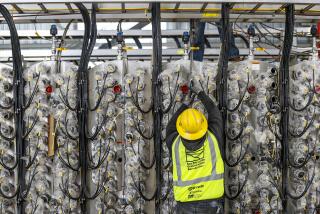EPA Lifts Curbs on GE Division in Anaheim : Pollution: Toxic-waste violations are remedied and a cleanup plan is enacted, agency rules, so firm can again handle PCBs.
ANAHEIM â Federal officials on Friday lifted restrictions on a General Electric Co. plant here, saying the company has remedied toxic-waste violations cited by the U.S. Environmental Protection Agency and has developed a cleanup plan to handle spilled waste.
The plantâs federal permit to handle polychlorinated biphenyls (PCBs) was suspended two weeks ago because the EPA found that the hazardous chemicals had contaminated the soil, asphalt and worker equipment. The agencyâs inspectors also said the company was storing more PCB waste than it could safely and legally handle.
The agency renewed the permit after inspecting the GE Apparatus Service Center on Wednesday. The company, however, must still check for buried contamination.
âThey have been very responsive to our concerns and they put in a lot of time and effort in getting their facility in compliance,â said Greg Czajkowski, chief of the toxics division at EPAâs western regional office in San Francisco. âTheyâve provided us with a very impressive plan for site sampling for PCB contamination. It looks like that will move ahead quite well.â
The companyâs plant manager, Mel Dinkel, said in a statement Friday that GE management âis pleasedâ by the reinstatement.
âWe plan to continue to operate a facility which does not pose a risk to human health or the environment. We also will continue to cooperate with the EPA to maintain full compliance with its rules and regulations,â the statement said.
Dinkel said that when the suspension occurred GE believed the plant was in full compliance with all EPA rules, but he has declined to elaborate.
The EPA is still considering imposing fines or other penalties against GE, Czajkowski said.
Meanwhile, an investigation of the plant by Cal/OSHA, the stateâs worker-safety agency, is continuing. A union official said a Cal/OSHA inspector told him that 42 health and safety violations have been identified, including lack of proper protective clothing and respirators for workers.
The Anaheim plant is the only facility in Southern California that decommissions old electrical transformers that contain PCBs. The GE workers drain the fluids from the huge pieces of equipment, then prepare them for disposal.
PCBs, widely used as insulators in electrical equipment for decades, were banned from U.S. production in 1979 because of their toxicity to humans and tendency to accumulate in the food chain and the environment.
GE officials feared employee layoffs if the suspension lasted much longer, Czajkowski said. The company had been granted 15 days to resolve the EPAâs concerns or face further action.
The EPA and Cal/OSHA investigations were triggered by an employee who complained about unsafe practices in handling the chemicals.
Steve Sandberg said he started complaining to his employers and authorities last summer after unusual skin lesions appeared on his thighs and PCBs were detected in his blood. Sandberg, who had worked for 2 1/2 years with the chemicals, was transferred out of the PCB department in October on doctorâs orders.
Several other GE employees also told The Times that the company did not provide health and safety equipment for the workers and that PCBs were spilled routinely.
The contamination concerned the EPA because it can soak into the skin of workers and easily contaminate the areaâs soil and waterways. Czajkowski said the PCBs in the soil and asphalt have been cleaned up.
âCurrently there is no exposure problem,â he said. âTheyâve essentially cleaned and resurfaced. There may be some historical contamination underneath the asphalt, but thatâs something their site study will address.â
Health problems linked in some cases to PCBs include chloracne, a skin disease, as well as increases in malignant melanoma and liver cancer. The EPA has classified the chemicals as probable human carcinogens.
In renewing the permit, the agency attached some conditions, mainly concerning where the waste can be stored and handled. The company is also developing a plan for taking care of rainwater that in the past might have washed PCBs onto nearby property.
PCB disposal accounts for about 20% of the earnings at the Anaheim plant, which has $18 million in annual sales and 94 employees. Three workers are permanently assigned to the PCB disposal staff, while several others handle the waste part time, and many others previously worked there.
More to Read
Sign up for Essential California
The most important California stories and recommendations in your inbox every morning.
You may occasionally receive promotional content from the Los Angeles Times.










